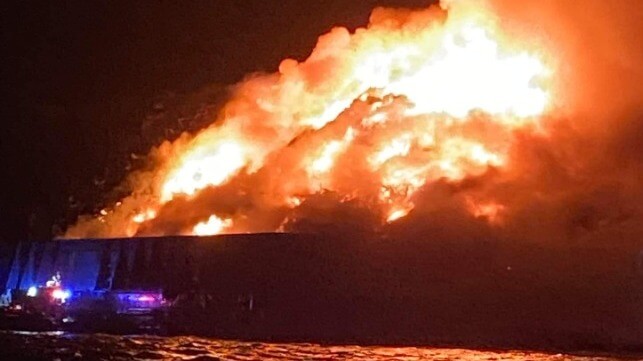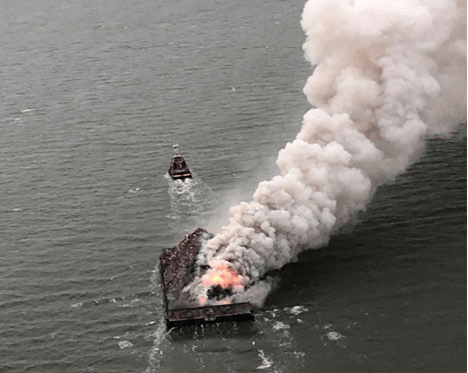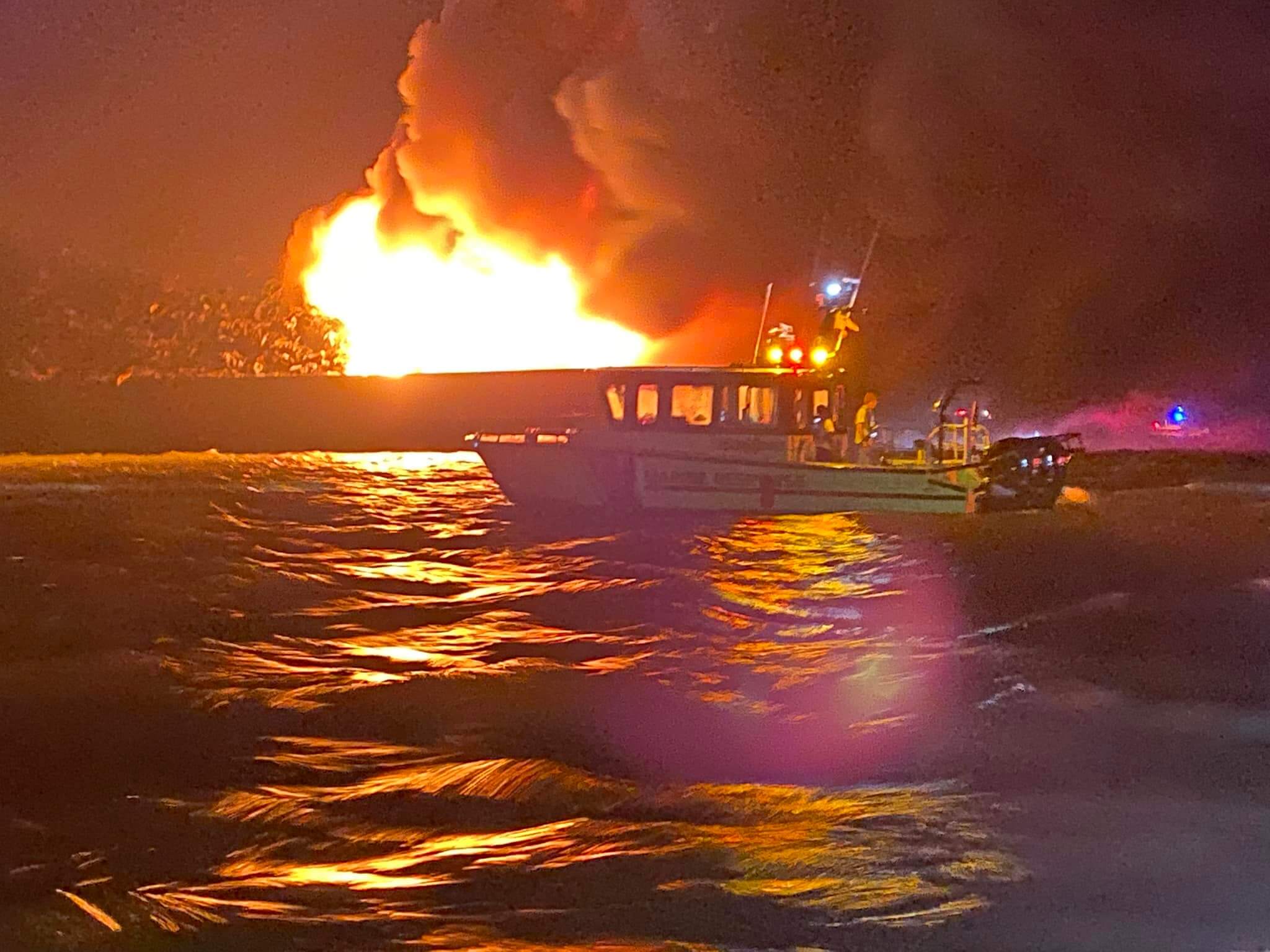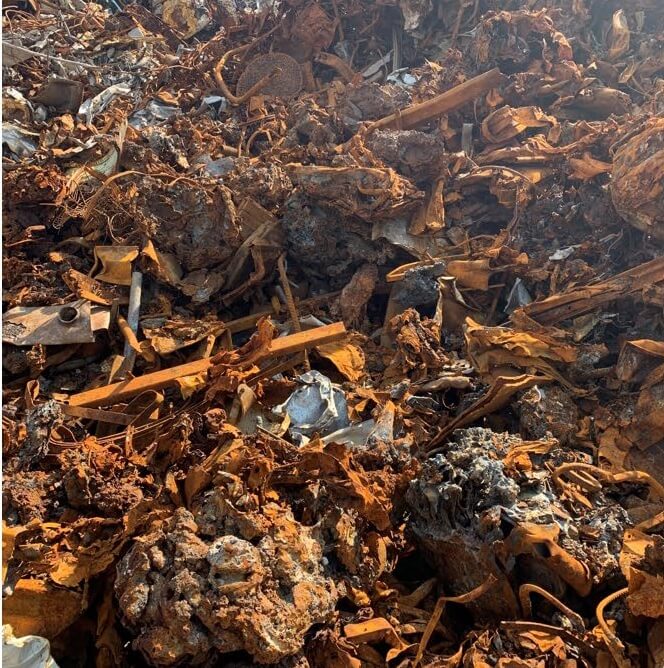NTSB: Scrap Metal Can Be a Fire Hazard, Even If It's Not an IMDG Cargo

In a warning to shipping published Thursday, the National Transportation Safety Bureau highlighted the fire risk inherent in scrap metal cargoes, particularly from hazardous and flammable contaminants like lithium-ion batteries. Though scrap metal is not rated as a hazardous cargo, and is usually treated like any other bulk commodity, NTSB cautioned that these contaminants can create risks for shipping.
A fire last year aboard a scrap barge in the Delaware Bay illustrates the potential for intense and dangerous blazes, even hot enough to melt metal.
On May 21, 2022, the tug Daisy Mae made up tow with the deck barge CMT Y Not 6 at an EMR-operated recycling facility in Newark. EMR's shoreside team had already loaded the barge with about 7,000 tons of low-grade steel scrap, known in the trade as "shredder feed." This mixture includes recyclable waste steel like whole crushed cars, appliances, and any other steel bigger than a quarter of an inch in thickness. This grade also contains lots of non-steel waste, and these unwanted extra materials get removed at a shredding plant - in this case, EMR's industrial shredding facility in Camden.
There was nothing unusual about this route or the cargo, the captain told NTSB. The Daisy Mae navigated out the Kill van Kull, out of New York Harbor, down the Jersey coastline, and into the Delaware River Channel. In the early hours of May 23, as the tug transited up the Delaware Bay towards Camden, the AB on watch saw smoke and an illuminated glow aboard the barge, on the port side aft. He told the mate, who sounded the general alarm and roused the captain.

Courtesy USCG
The fire rapidly expanded, and the crew notified the Coast Guard. To secure the barge in position for firefighting efforts, they transited to shallow water and anchored on the tow wire.
Six firefighting boats and a Coast Guard response boat attended the scene, and the responders managed to extinguish the fire after 24 hours of operations. The fire was largely contained to the barge's stern.
 Courtesy Memorial Fire Company
Courtesy Memorial Fire Company
After the fire was out, Daisy Mae completed her planned voyage to the Camden plant. When the scrap was offloaded, surveyors found that the fire had buckled the barge's bin walls and side shell plating, and the main deck had sagged up to a foot and a half in the area of the blaze. Several internal bulkheads had heat damage as well. The total cost of repairs was estimated at about $7 million.
On inspecting the fire-damaged scrap, NTSB and the Coast Guard found that some of the metal had liquefied, then re-hardened into large chunks. In the undamaged scrap, the inspectors found plastic waste, rubber tires and electrical components, among other flammables.

Globules of melted and resolidified metal in the burned scrap pile (NTSB)
The exact cause of the fire could not be determined. NTSB identified many possible ignition sources, like sparks from shifting and grinding metal during transit, self-heating materials like oily rags, or improperly-disposed-of lithium-ion batteries. EMR's VP of operations acknowledged that the increasing prevalence of lithium-ion batteries is a known problem for the scrap industry, and that it is difficult to fully exclude batteries from large piles of scrap steel. However it started, the fire was able to feed on abundant fuel from flammable contaminants within the cargo.
The investigators noted multiple recent scrap-metal fires aboard foreign-flagged ships, including the fire that destroyed the freighter Tai Yuan in Japan in 2017.
"Metallic and nonmetallic hazardous materials often are present within shoreside scrap metal piles and could be loaded onto vessels. These often-flammable materials elevate the fire risk and can lead to intense fires," noted NTSB. "Qualified cargo-surveying personnel can assist the vessel’s captain before and during loading operations to limit the presence of hazardous, combustible material in scrap metal. Thermal imagery is an effective tool that could be used to identify hot spots in scrap metal cargo at shoreside facilities."
